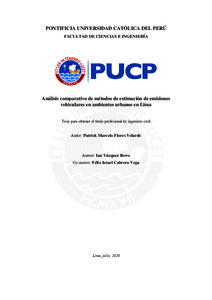| dc.contributor.advisor | Vázquez Rowe, Ian | |
| dc.contributor.author | Flores Velarde, Patrick Marcelo | |
| dc.date.accessioned | 2020-12-09T21:34:34Z | |
| dc.date.available | 2020-12-09T21:34:34Z | |
| dc.date.created | 2020 | |
| dc.date.issued | 2020-12-09 | |
| dc.identifier.uri | http://hdl.handle.net/20.500.12404/17651 | |
| dc.description.abstract | Actualmente, el cambio climático es un fenómeno que afecta a la vida en el planeta Tierra. En
este ámbito, existen diferentes dificultades a sortear para poder preservar el medio ambiente.
Algunas de las dificultades que existen se revisan en las páginas siguientes y están relacionadas
con la cuantificación de los contaminantes aéreos. La guía desarrollada por la Unión Europea
(UE) para el cálculo de emisiones vehiculares propone tres métodos para el cálculo de
emisiones. Estos métodos son utilizados dentro del marco del Análisis de Ciclo de Vida
(ACV) y se presume que no reflejan adecuadamente las emisiones totales. Por ello, en este
documento se busca desarrollar un método que brinde una mayor precisión al calcular las
emisiones provenientes de los vehículos motorizados en ciudades. Esta metodología incluye
el desarrollo de un modelo de microsimulación de tráfico, del cual se obtienen los datos de
velocidades y aceleraciones de cada vehículo para cada segundo de simulación. Con estos
datos se calculan las emisiones mediante un software de modelado de emisiones (CMEM), el
cual considera ciclos de aceleración y desaceleración. Luego de realizarse el modelo y el
cálculo de las emisiones se extraen los factores de emisión y se procede a una comparación.
Durante la comparación con dos de los tres métodos propuestos por la UE se observa que los
factores calculados mediante el CMEM son mayores para el caso de monóxido de carbono
(CO) y menores en el caso del dióxido de carbono (CO2) respecto a los brindados por la guía
europea. Esto nos permite concluir que al acelerar y/o desacelerar se deja de emitir CO2 y en
su lugar se emite más CO. De esta forma, se da una situación no deseada en el ámbito urbano,
pues el CO favorece la formación de smog fotoquímico. Así, se afirma que utilizando los
métodos europeos se pasa por alto un potencial daño a la salud humana cuando se realizan
estimaciones en ambientes netamente urbanos. | es_ES |
| dc.description.abstract | Currently, climate change and air quality are two of the major phenomena that affect human
wellbeing on planet Earth. The former thrives on ever-growing greenhouse gas (GHG)
emissions due to a set of critical human-related activities, including transport. The latter is of
critical importance in urban environments, mainly due to the use of fossil fuels for transport
and heating and cooling devices. However, the computation of traffic in life-cycle modelling
lacks in most cases the effect of speed, acceleration and deceleration, as well as driving
behavior in general, on exhaust pollutant emissions. In this context, Lima, located in a
temperate desert, is well known to owe most of its air pollution to traffic, as well as its high
level of congestion. Therefore, the aim of this study is to develop a method that provides
greater precision when calculating emissions from motor vehicles in cities, using the city of
Lima as a case study. The methodology applied includes the development of a traffic
microsimulation model, from which the speed and acceleration data of each vehicle are
obtained for each second of simulation. With this data, exhaust emissions are calculated using
an emission modeling software (CMEM), which considers acceleration and deceleration
cycles. Once the model and calculation of the emissions are made, emission factors are
extracted and a comparison is realized. This comparison is undergone with the first two
methods (i.e., Tiers 1 and 2) proposed by the European Environmental Agency’s guide for the
calculation of vehicle emissions. These methods are commonly used within the framework of
the Life Cycle Assessment (LCA) and it is presumed that they do not adequately reflect total
emissions. The results obtained in the comparison confirm that the factors calculated using
CMEM are considerably higher in the case of carbon monoxide (CO), but lower in the case of
carbon dioxide (CO2) compared to those provided by the European guide. This suggests that
acceleration and deceleration processes enhance air quality pollutants in urban environments,
fostering the formation of photochemical smog, whereas climate change emissions dwindle.
Thus, it is claimed that using European methods, potential harm to human health is overlooked
when estimates are made in purely urban environments. | es_ES |
| dc.language.iso | spa | es_ES |
| dc.publisher | Pontificia Universidad Católica del Perú | es_ES |
| dc.rights | info:eu-repo/semantics/openAccess | es_ES |
| dc.rights.uri | http://creativecommons.org/licenses/by/2.5/pe/ | * |
| dc.subject | Aire--Contaminación--Control | es_ES |
| dc.subject | Contaminantes--Evaluación | es_ES |
| dc.subject | Motocicletas--Aspectos ambientales | es_ES |
| dc.title | Análisis comparativo de métodos de estimación de emisiones vehiculares en ambientes urbanos en Lima | es_ES |
| dc.type | info:eu-repo/semantics/bachelorThesis | es_ES |
| thesis.degree.name | Ingeniero Civil | es_ES |
| thesis.degree.level | Título Profesional | es_ES |
| thesis.degree.grantor | Pontificia Universidad Católica del Perú. Facultad de Ciencias e Ingeniería | es_ES |
| thesis.degree.discipline | Ingeniería Civil | es_ES |
| renati.advisor.cext | 001084152 | |
| renati.advisor.orcid | https://orcid.org/0000-0002-7469-2033 | es_ES |
| renati.author.dni | 71712191 | |
| renati.discipline | 732016 | es_ES |
| renati.juror | Kahhat Abedrabbo, Ramzy Francis | es_ES |
| renati.juror | Vazquez Rowe, Ian | es_ES |
| renati.juror | Gusukuma Higa, Marco Antonio | es_ES |
| renati.level | https://purl.org/pe-repo/renati/level#tituloProfesional | es_ES |
| renati.type | https://purl.org/pe-repo/renati/type#tesis | es_ES |
| dc.publisher.country | PE | es_ES |
| dc.subject.ocde | https://purl.org/pe-repo/ocde/ford#2.01.01 | es_ES |






